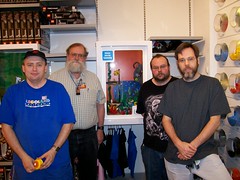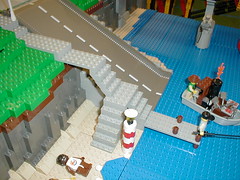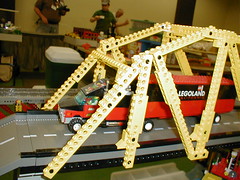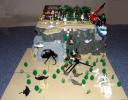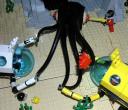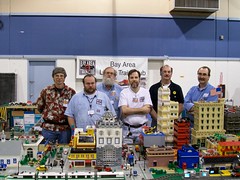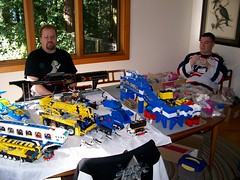Stephen and Austin Nolen have produced an amazing video for the song “1985” by Bowling For Soup. Now I don’t know whether they got permission from the band to use the song, but I love what they came up with. It’s a great song, and the LEGO animations fit the music very well. It’ll take a while to download though, so start the download and then make yourself a nice lunch. Depending on your Internet connection you might want to get dinner started while you’re at it.
[tags]LEGO, Animation, Brickfilm, BowlingForSoup, 1985[/tags]
Scissor Lift in Technic?
Have you ever tried building a scissor lift in [tag]LEGO[/tag]? I’m working on a project that calls for that kind of mechanism to lift it up, like those food service trucks at the airport. It is based on an “X” shaped arrangement, which, like the two parts of a scissors pivot at the middle. By bringing together the two bottom (or top) ends, the top is lifted into the air.
The approach I took was to use [tag]Technic[/tag] worm [tag]gears[/tag] (like a screw) with a rack gear on it. By turning the worm gears the rack gear should move along its length, which moves the two bottom ends together, elevating the top. The problem is that LEGO gears just aren’t up to the load this places on them, and the teeth skip. I motorized it, gearing down the motor to get more torque, but the gears would rather skip than lift the weight.
Has anyone out there successfully built this kind of [tag]scissor lift[/tag] mechanism in LEGO to lift a nontrivial weight? If so please comment below or email me any tips you may have. Thanks!
P.S.: Sorry for the gap in posts – I’ve been sick with a bad cold for a week or so…
Aquarium display at LEGO store
With other members of the Bay Area LEGO Users Group, I helped install a new [tag]aquarium[/tag]-themed display at the Stoneridge Mall [tag]LEGO[/tag] store in [tag]Pleasanton[/tag], CA on Feb 20, 2006. My contributions to this display were two fish and some seaweed.
The fish that appear to be floating in air, and the seaweed that I created (on the left side of the “tank,” made out of LEGO palm frond pieces) are suspended by threads, at the other end of which are magnets that cling to the shelf above the display. The large octopus is suspended by threads too, but it’s too heavy for magnets so the threads are wrapped around the shelf supports.
See photos on Flickr or on Brickshelf.
Coastline
This is another model that I built 3 years ago but only recently posted the pictures online.
This, along with the recently posted Road Bridge, was built for the BayLTC train layout in 2003.
The cliff module was designed to come apart into several sections for ease of transportation and storage. Each section connected to the next one using Technic pegs. At one end, I built a peninsula with a space for Russell Clark’s lighthouse. It had an opening, recessed by one plate’s thickness, to accomodate a 16×32 stud baseplate.
The launch ramp road piece, like the road pieces on the bridge, came from LEGO’s 6600 Highway Construction set. It had stairs leading down to a small dock.
The lifeguard tower and beachgoers were contributed to the layout by club member Mark Benz.
[tags]LEGO, cliff[/tags]
Any LEGO Fans from South Carolina?
My wife and I will be traveling to South Carolina (visiting Hilton Head and Charleston) next month. If you’re in that area and would like to meet up, send me mail or comment under this entry.
Road Bridge
In 2003 (or maybe 2002) I built a bridge for the BayLTC train layout. But it wasn’t a train bridge, it was a road bridge (for cars and trucks).
The road pieces came from LEGO’s 6600 Highway Construction set, and the bridge’s structural elements were built of Technic bricks.
Most of the angles in the bridge truss design follow some multiple of the 3-4-5 triangle. This is one of the most useful laws of trigonometry: if you have a triangle with sides 3, 4, and 5, or any multiple of that (such as 30, 40, 50) then they will form a perfect right triangle (a triangle where one of the angles is exactly 90 degrees). Why? Because of the Pythagorean Theorem: in any right triangle, the square of the hypotenuse (the side opposite the 90° angle) is always equal to the sum of the squares of the other two sides. And it so happens that 32 + 42 (9 + 16) is equal to 52 (25).
In LEGO, the 3-4-5 triangle is achieved by attaching pieces in distances of 4-5-6 studs. Why? Because of the “fencepost effect” – if you make the connection on the 1st and 4th stud, that’s actually a distance of 3 (since 4-1=3). The same goes for the 4 and 5 unit length sides. In this model, the center trusses are formed by 3-4-5 triangles scaled up by a factor of 6. So the “4” sides (the vertical) are really 24 (actually 25, because of the fencepost effect) tall. The angled trusses are made by sheer guesswork, however. Luckily, there’s enough slop in LEGO connections to make it not really be necessary to always get it just right. When working on this, I built what I called a “Pythagorometer” – a model of the 3-4-5 triangle at various scales – to try to make the angles work out. I’ll post more about that later.
I recently discovered a batch of pictures of this bridge that had never been posted online, taken at the July 2003 GATS layout. You can see them at a Flickr gallery.
LEGO is Not a Crime!
Except in Germany, that is. It seems that a LEGO fan was recently arrested for playing with [tag]LEGO[/tag] [tag]Mindstorms[/tag] on a train. Thanks to my wife Holly for pointing this out.
The question is, how could anyone think that a robotics kit made from LEGO could be used to make a [tag]bomb[/tag]? I’ll give the cops credit for being creative, at least. I hope the guy gets his Mindstorms kit back!
Treasure Reef
Today’s entry features a creation by a Czech [tag]LEGO[/tag] fan named Jindrich Kubec.
It’s called the Treasure Reef and is really two models in one. I came across the announcement on LUGNET a few days ago and was very impressed. The diorama consists of two main areas, plus a story in pictures:
First, there is a [tag]beach[/tag] scene with a bar, sunbathers, and volleyball court. I especially liked the sand castle and volleyball game.
But when you lift off the water (represented by blue baseplates) you can access the other part, an [tag]underwater[/tag] scene, featuring a cave of treasures protected by an octopus-like monster. There’s also a whale skeleton which came from an old LEGO set.
Finally, there is also a story in pictures, as a variation of the underwater scene, where divers fight to obtain the treasure from the [tag]sea monster[/tag] in the cave.
All the pics can be viewed by clicking the above links, or view the whole gallery on Brickshelf.
I was very impressed because of the sheer originality of this diorama. Although elements of the set (such as the whale skeleton) came from official LEGO models most of it – and the idea of combining the things together like this – is very original.
Bay Area LEGO Train Club at Pleasanton Train Show in Nov. 2005
Last November, BayLTC participated in the Pleasanton, CA, Great Western & Atlantic Train Show at the Alameda County Fairgrounds. The event was held on the weekend following Thanksgiving. View the pictures on Flickr or on Brickshelf (once moderated).
Our next show will be at the TCA Cal-Stewart Meet in Santa Clara, which will be open to the public on Sunday, March 12.
[tags]LEGO, BayLUG, BayLTC, Train Show[/tags]
Bay Area LEGO Users’ Group Meeting on Jan. 22, 2006
Yesterday I attended a BayLUG club meeting at the home of one of our members, Dave Porter, in Woodside, CA. Dave sets up a [tag]LEGO[/tag] train layout in his upstairs loft every year around the holidays and it is going to be torn down in a week, so he invited the club to come to his house to see it while we still could. [tag]BayLUG[/tag] members brought their latest models to show off, and there was a lot of buying and selling of parts, including “Uncle Dan” and his bulk LEGO by the pound. View the pictures on Flickr or on Brickshelf (once moderated).

